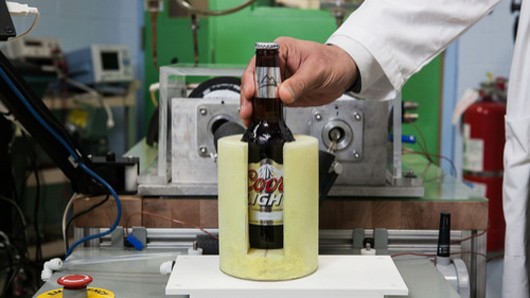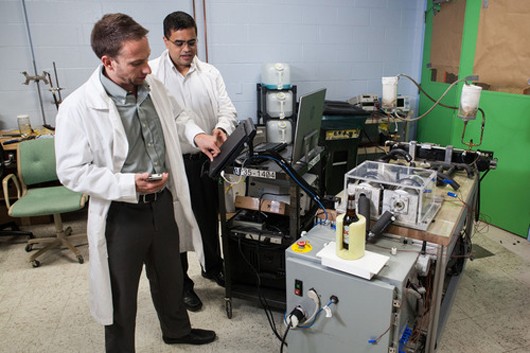Your next fridge could keep cold more efficiently using magnets
By Darren Quick
February 13, 2014

A bottle of beer is cooled using the new magnetic refrigeration system developed by GE
The fridge is the most common of common household appliances. Despite improvements in efficiency over the years, they remain one of the biggest users of electricity in the home, relying on chemical refrigerant and a compressor to transfer heat from the inside to the outside of the fridge. GE researchers have now developed a new type of refrigeration technology using magnets that is more environmentally friendly and is predicted to be 20 to 30 percent more efficient that current technology ... and it could be in household fridges by the end of the decade.
Magnetic refrigeration is not a new idea. Ever since German physicist Emil Warburg observed in the 1880s that certain materials changed temperature when exposed to a changing magnetic field – known as the magnetocaloric effect – there have been efforts to create refrigerators based on the technique.
Such magnetic refrigeration systems were developed as far back as the 1930s, and researchers at the Los Alamos National Laboratory (LANL) in New Mexico successfully achieved a few degrees of refrigeration in the 1980s. However, the technology has failed to make it into household refrigerators as it relies on superconducting magnets that themselves need to be cooled to extremely low temperatures, making it not cost- or energy-efficient for household use.
GE teams in the US and Germany turned their collective efforts to the task a decade ago and built a cascade from special magnetic materials. Each step of the cascade lowered the temperature slightly but after five years of work they were only able to realize cooling of just 2° F (1° C) with a prototype that Michael Benedict, design engineer at GE Appliances, describes as a "huge machine."
A breakthrough then came courtesy of the research team's materials scientists who developed a new type of nickel-manganese alloys for magnets that could function at room temperatures. By arranging these magnets in a series of 50 cooling stages, the team have managed to reduce the temperature of a water-based fluid flowing through them by 80° F (45° C) with a device that is, according to Benedict, "about the size of a cart."
"Nobody in the world has done this type of multi-stage cooling,” said Venkat Venkatakrishnan, a leader of the research team. "We believe we are the first people who shrunk it enough so that it can be transported and shown. We were also the first to go below freezing with the stages."
The team has demonstrated the system for experts from the Department of Energy (DoE), White House staffers and the EPA and is now working to further refine the technology. They hope to achieve a 100° F (56° C) drop in temperature at low power, with the ultimate goal of replacing current refrigerator technology, possibly before the end of the decade.
"We’ve spent the last 100 years to make the current refrigeration technology more efficient,” said Venkatakrishnan. "Now we are working on technology for the next 100 years."
The magnetocaloric refrigeration technology is explained in the following video.
Source: GE

 Darren's love
of technology started in primary school with a Nintendo Game & Watch
Donkey Kong (still functioning) and a Commodore VIC 20 computer (not
still functioning). In high school he upgraded to a 286 PC, and he's
been following Moore's law ever since. This love of technology
continued through a number of university courses and crappy jobs
until 2008, when his interests found a home at Gizmag.
Darren's love
of technology started in primary school with a Nintendo Game & Watch
Donkey Kong (still functioning) and a Commodore VIC 20 computer (not
still functioning). In high school he upgraded to a 286 PC, and he's
been following Moore's law ever since. This love of technology
continued through a number of university courses and crappy jobs
until 2008, when his interests found a home at Gizmag.